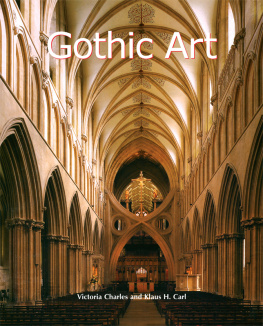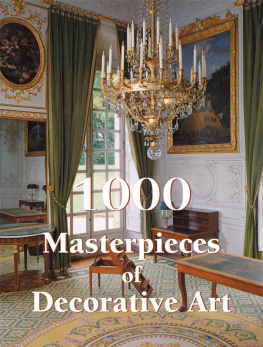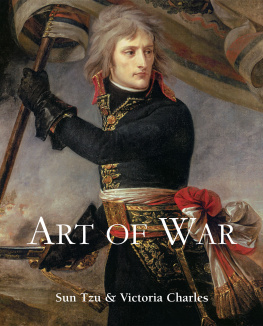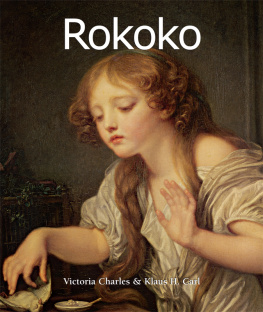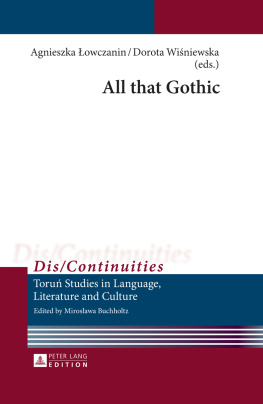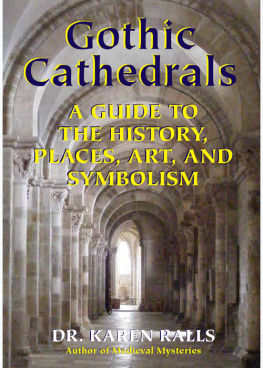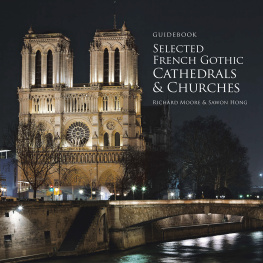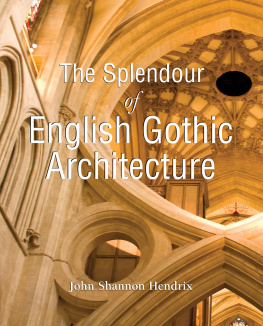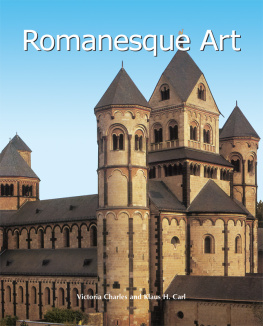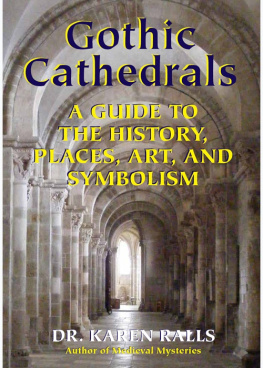Author: Victoria Charles and Klaus H. Carl
Translator: Andrea Hacker
Layout:
Baseline Co. Ltd
61A-63A Vo Van Tan Street
4 th Floor
District 3, Ho Chi Minh City Vietnam
Parkstone Press International, New York, USA
Confidential Concepts, Worldwide, USA
All rights reserved.
No part of this book may be reproduced or adapted without the permission of the copyright holder, throughout the world. Unless otherwise specified, copyright on the works reproduced lies with the respective photographers. Despite intensive research, it has not always been possible to establish copyright ownership.
Where this is the case, we would appreciate notification.
ISBN: 978-1-78310-324-9
Victoria Charles and Klaus H. Carl
G othic A rt

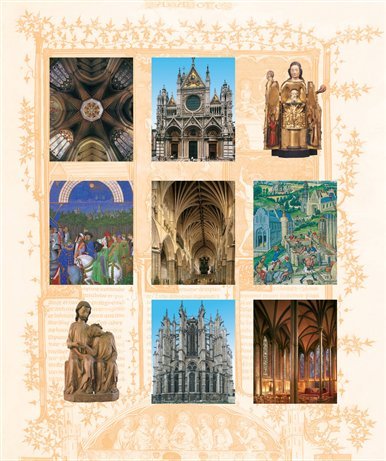
Contents
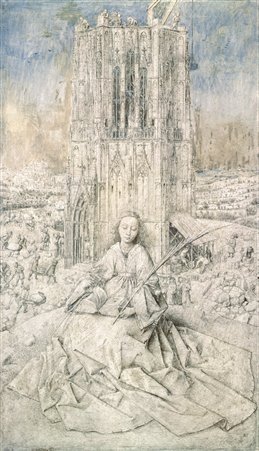
1. Jan Van Eyck, St. Barbara, 1437.
Silverpoint on paper, 31 x cm .
Koninklijk Museum voor Schone Kunsten,
Antwerp (Belgium).
Introduction
The beginning of the Gothic age cannot be dated precisely; it lies sometime in the mid-twelfth century and slowly replaced the Romanesque age. Its end is likewise indefinable but is believed to be sometime at the beginning of the fifteenth century. Some time later the Italian painter, master builder and writer Giorgio Vasari used the term gothic (which means barbaric) to describe the new way of building that came to Italy over the Alps. No matter how much the Italians tried to resist, the Gothic would soon supplant at least the exterior of their Romanesque style, which had been informed by Antiquity. It was spread predominantly by German stonemasons and foremen. From the invasions and pillaging by both the Visigoths and Ostrogoths, and their long domination in Italy, the Italians remembered all too well that German and Gothic meant one and the same thing. But, just as the Romanesque was truly a German style, the Gothic style is of French origin, as the foundation of Gothic architectural art developed first in the northern part of France, around Paris.
However, Gothic architectures apex of artistic creation and strength was displayed with its last development in the cathedrals of Cologne (see p.. By the time the Gothic reached this stage, its power was exhausted. Any number of Gothic churches could be built, once a perfect system existed that could be followed all that was needed were sufficient means and inclination. But new formations could not emerge from this locked, continuous system that no longer offered any starting point for further development. While the Romanesque style displayed great freshness and flexibility in its final phase, the Gothic style ended in decrepitude. Still, the merit of the most refined Gothic works lies in their harmonious merging of courageous imagination with intelligent calculation: the former knows no obstacle, while the latter is testimony to a practical, deliberating mind. However, the early Gothic creations, in which the bravery of discoverers and inventors made its first, tempestuous attempts, are artistically more stimulating. Subsequently, the irregular, purely picturesque aspect of Gothic buildings, and particularly the richness of their plastic ornamentations, is likewise more interesting than the perfect, yet cold regularity of those constructions that represented the highest achievements of Gothic architectural art.
The young poet and natural scientist, Johann Wolfgang von Goethe, viewed Strasbourg Cathedral with passionate enthusiasm (see p. ). After him, the German Romantics gazed at the majestic creations of the Gothic style and considered them to be arts highest achievements. This enthusiasm was replaced by a cooler perspective since research of archival documents determined that the roots of the Gothic are French. Not only were French master builders called abroad to introduce the new building style, German master builders and stonemasons also went to France, mainly to Paris, where, from the end of the eleventh century, cultural conditions emerged to which Gothic architecture owes the best part of its growth and development.
The most important of these cultural conditions was the strengthening of the townsfolk and the blossoming of cities. Citizens sought an expression of their wealth and subsequent power in the construction of towering places of worship. Far and wide, they were testimony to both the maturation and greatness of cities. Just as the French court ceremony and chivalrous gallantry gradually suffused fashion, language, poetry, and eventually all aspects European life, Gothic architecture flourished in all those countries which had been penetrated by French culture. The Gothic style accommodated the abovementioned cities impulses to display their growing power, as well as the practical need for bright, spacious churches that came with incremental population growth. Additionally, there were religious reasons, namely the deep piety that constituted the ethical foundation of medieval man and his yearning for the bliss of Heaven, which is visible externally in the towers reaching for Heaven and internally in the pillar constructions that lift the vaults up to vertiginous heights.
This longing for heights, this yearning for Heaven is not the only, but is certainly one of the decisive reasons for the vertical tendency in the development of Gothic architecture, which is so unlike the horizontal tendency of the Romanesque style. Still, the influence of this spiritual element on the development of the Gothic should not be overestimated. It was always purely technical rather than aesthetic considerations that were at the forefront of Gothic craftsmanship. In the same way that the French masters had devised a new system of vaulted ceilings for purely practical reasons, building technology moved forward with similarly practical concerns. The medieval architects already knew that a building could be turned into an organic work of art, but only from the inside out. That is why the creation of the exterior was the least of their worries, as long as there were no pressing construction concerns; it was the task of the stonemasons, who executed the plans of the highest church-foreman (the architect in the modern sense). This is the reason why, during the reign of this style, the tall spires which give each Gothic church its aesthetic completion were often only finished in smaller scale buildings.
The Gothic architectural style did not emerge as a unified whole, but gradually developed into a system. The artistic and architectural Gothic style, which, in the twelfth century immediately followed, and in parts even coincided with, the final flourish of the Romanesque, at first continued the system of the vaulted basilica, as it had been developed in the Romanesque period. The ground plan of church monuments and the main arrangement of rooms remained the same. Only in terms of architecture is the Gothic style clearly distinguishable.
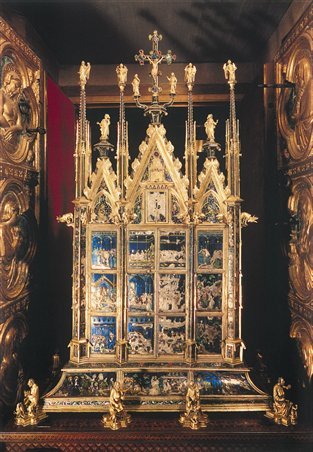
2. Ugolino di Vieri,
Reliquary of the Corporal of Bolsena,
Orvieto Cathedral, Orvieto (Italy), 1337-1338.
Enamelled and gilded silver, h: 139 cm. In situ.


